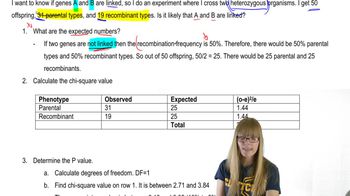Here are the essential concepts you must grasp in order to answer the question correctly.
Recombination Frequency
Recombination frequency is a measure of the likelihood that two genes will be separated during meiosis due to crossing over. It is calculated by dividing the number of recombinant offspring by the total number of offspring, often expressed as a percentage. This frequency provides insights into the genetic linkage between genes, with lower frequencies indicating closer linkage.
Recommended video:
Recombination after Single Strand Breaks
Genetic Linkage
Genetic linkage refers to the tendency of genes located close to each other on a chromosome to be inherited together during meiosis. Linked genes do not assort independently, which can affect the ratios of phenotypes observed in offspring. Understanding linkage is crucial for interpreting recombination frequencies and mapping genes on chromosomes.
Recommended video:
Phenotype and Genotype
Phenotype refers to the observable characteristics or traits of an organism, which result from the interaction of its genotype (the genetic makeup) with the environment. In genetic studies, distinguishing between different phenotypes, such as mutants and wild types, is essential for analyzing inheritance patterns and calculating recombination frequencies.
Recommended video:






